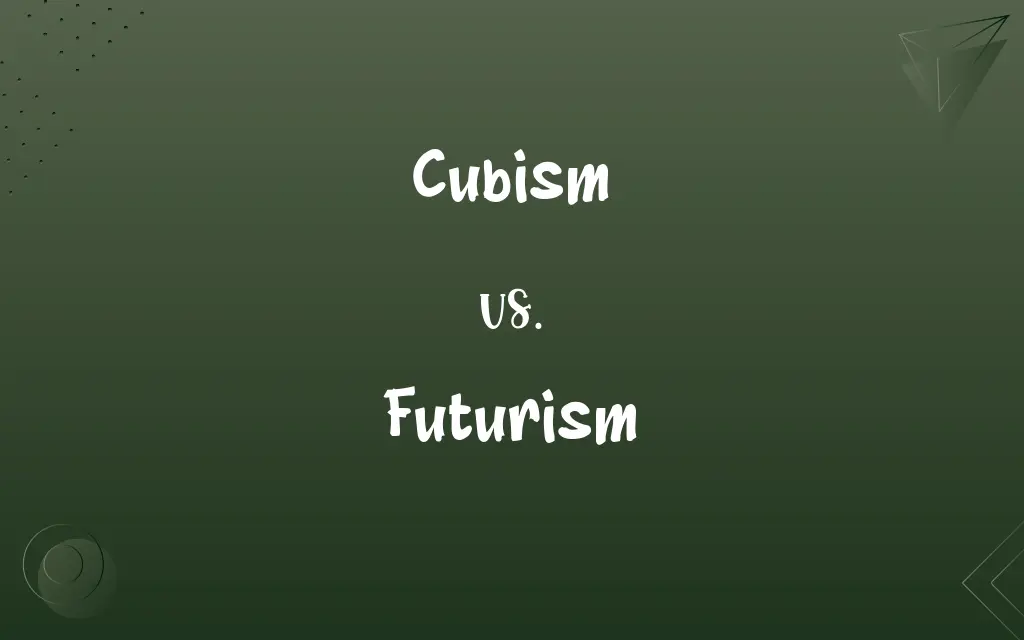Cubism vs. Futurism: Know the Difference

By Dua Fatima & Hifza Nasir || Published on November 10, 2024
Cubism focuses on multiple perspectives and geometric shapes, whereas Futurism emphasizes speed, technology, and modernity.

Key Differences
Cubism, developed by Pablo Picasso and Georges Braque in the early 20th century, breaks down objects into geometric shapes, presenting multiple perspectives within a single plane. This approach aims to depict the complexity of seeing the world beyond the limitations of traditional perspective. On the other hand, Futurism, founded by Filippo Tommaso Marinetti in 1909, celebrates the dynamism and energy of modern technology, speed, and industrial progress. It seeks to capture the motion and force of objects, often incorporating elements of the machine age.
Hifza Nasir
Nov 10, 2024
While Cubism often utilizes a more muted, monochromatic palette to emphasize its structural compositions, Futurism is known for its vibrant colors and dynamic lines, striving to evoke the sensation of movement and the energy of the industrial and technological advances. The use of color and line in these movements reflects their distinct thematic focuses: Cubism's analytical deconstruction of form versus Futurism's emphasis on the dynamic qualities of modern life.
Dua Fatima
Nov 10, 2024
Cubism tends to focus on still life and portraits in a static, analytical form, dissecting and reassembling subjects to explore their inherent spatial relationships. Conversely, Futurism often depicts scenes of urban landscapes, machines, and humans in motion, illustrating a world in constant change and celebrating the beauty of the future.
Dua Fatima
Nov 10, 2024
In terms of influence, Cubism had a profound impact on the development of modern art, influencing later movements such as abstract expressionism and minimalism with its emphasis on abstraction and the reduction of forms to their geometric essentials. Futurism, while also influential, is more closely associated with its impact on the aesthetics of speed and its anticipation of the technological advancements of the 20th century, influencing areas beyond art, including architecture, fashion, and even literature.
Dua Fatima
Nov 10, 2024
Cubism and Futurism both represent pivotal movements in the history of modern art, yet their philosophies and aesthetic approaches diverge significantly. Cubism's introspective examination of form and perspective contrasts with Futurism's outward-looking celebration of movement and technology, each offering a unique lens through which to view the evolving world of the early 20th century.
Dua Fatima
Nov 10, 2024
ADVERTISEMENT
Comparison Chart
Color and Line
Muted palette, emphasis on structure
Vibrant colors, dynamic lines
Dua Fatima
Nov 10, 2024
Impact on Art
Influenced abstract expressionism, minimalism
Influenced architecture, fashion, literature
Hifza Nasir
Nov 10, 2024
ADVERTISEMENT
Cubism and Futurism Definitions
Cubism
Focus on the simultaneous presentation of multiple viewpoints.
Portrait of Ambroise Vollard by Picasso merges various perspectives into one image.
Dua Fatima
Mar 03, 2024
Futurism
Advocacy for the overthrow of traditional cultural and artistic institutions.
Marinetti's Futurist Manifesto calls for a rejection of the past.
Shumaila Saeed
Mar 03, 2024
Cubism
A technique that deconstructs objects into abstract forms.
Braque's still lifes utilize Cubism to explore spatial relationships.
Dua Fatima
Mar 03, 2024
Futurism
An artistic movement celebrating modern technology and dynamic motion.
Boccioni's Unique Forms of Continuity in Space embodies Futurism's focus on movement.
Dua Fatima
Mar 03, 2024
Cubism
An art movement characterized by geometric shapes and multiple perspectives.
Picasso's Les Demoiselles d'Avignon showcases Cubism's break from traditional representation.
Dua Fatima
Mar 03, 2024
ADVERTISEMENT
Futurism
Emphasis on the beauty of speed and industrial advancement.
Futurist paintings often depict machines and fast-moving vehicles.
Dua Fatima
Mar 03, 2024
Cubism
An exploration of the essence of objects beyond their appearance.
Cubist works aim to capture the subject's essence rather than its outward form.
Hifza Nasir
Mar 03, 2024
Futurism
Representation of motion and energy in art.
Russolo's The Revolt uses dynamic lines to convey the energy of modern life.
Dua Fatima
Mar 03, 2024
Cubism
Emphasis on the flatness of the canvas.
Cubist paintings often reject traditional depth cues to highlight the canvas's surface.
Hifza Nasir
Mar 03, 2024
Futurism
Incorporation of urban and industrial motifs.
Futurist art frequently features cityscapes and industrial scenes.
Hifza Nasir
Mar 03, 2024
Futurism
A belief that the meaning of life and one's personal fulfillment lie in the future and not in the present or past.
Dua Fatima
Mar 02, 2024
Futurism
An artistic movement originating in Italy around 1910 whose aim was to express the energetic, dynamic, and violent quality of contemporary life, especially as embodied in the motion and force of modern machinery.
Dua Fatima
Mar 02, 2024
Repeatedly Asked Queries
How do Cubism and Futurism differ in their use of color?
Cubism often employs a muted palette to focus on form and structure, while Futurism uses vibrant colors to convey motion and energy.
Dua Fatima
Nov 10, 2024
Who were the founders of Cubism?
Pablo Picasso and Georges Braque are credited with founding Cubism.
Dua Fatima
Nov 10, 2024
What is Futurism?
Futurism is an artistic and social movement that emphasizes speed, technology, and modernity, celebrating the dynamism of the 20th century.
Dua Fatima
Nov 10, 2024
Who wrote the Futurist Manifesto?
Filippo Tommaso Marinetti wrote the Futurist Manifesto in 1909.
Shumaila Saeed
Nov 10, 2024
What themes are common in Futurist art?
Common themes in Futurist art include movement, technological advancement, and the beauty of the industrial age.
Hifza Nasir
Nov 10, 2024
How did Futurism impact areas outside of visual art?
Futurism influenced architecture, fashion, and literature, promoting a futuristic aesthetic across various cultural domains.
Dua Fatima
Nov 10, 2024
What is Cubism?
Cubism is an art movement that breaks subjects down into geometric shapes, offering multiple perspectives within a single composition.
Hifza Nasir
Nov 10, 2024
Can you name a famous Cubist artwork?
"Les Demoiselles d'Avignon" by Pablo Picasso is a famous example of Cubism.
Dua Fatima
Nov 10, 2024
What distinguishes Futurism from other art movements?
Futurism's unique celebration of technology, speed, and the future distinguishes it from other art movements.
Hifza Nasir
Nov 10, 2024
Did Cubism and Futurism overlap in time?
Yes, both movements emerged in the early 20th century and overlapped in time, reflecting the era's rapid changes.
Shumaila Saeed
Nov 10, 2024
What role did technology play in Futurism?
Technology was central to Futurism, symbolizing progress, power, and the potential of the future.
Hifza Nasir
Nov 10, 2024
How do Futurist artworks convey movement?
Futurist artworks use dynamic lines, vibrant colors, and compositions that suggest speed and fluidity to convey movement.
Dua Fatima
Nov 10, 2024
How did Cubism influence other art movements?
Cubism influenced various modern art movements, including abstract expressionism and minimalism, through its exploration of abstraction and form.
Dua Fatima
Nov 10, 2024
Are there any similarities between Cubism and Futurism?
Both movements sought to break away from traditional artistic conventions, though their focuses—form versus motion—differ significantly.
Shumaila Saeed
Nov 10, 2024
Why did Cubism focus on geometric shapes?
Cubism used geometric shapes to explore the complexity of seeing and to depict subjects from multiple viewpoints simultaneously.
Shumaila Saeed
Nov 10, 2024
Share this page
Link for your blog / website
HTML
Link to share via messenger
About Author
Written by
Dua FatimaCo-written by
Hifza Nasir







































































